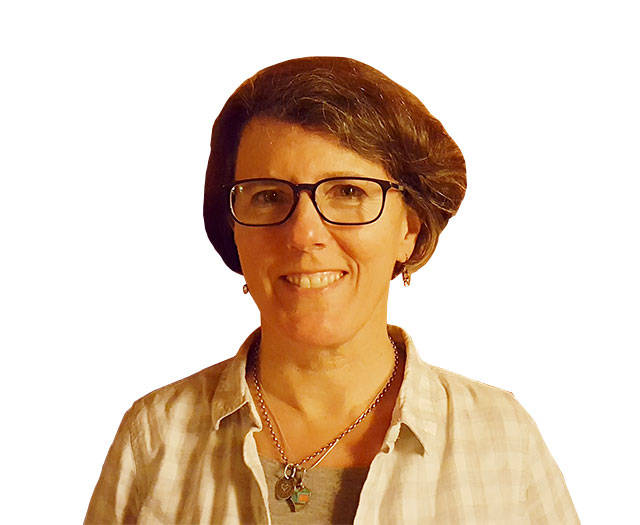For anyone who loves snow in the mountains, the data say it’s party time at the Dungeness Snotel* station!
On April 1, the “end of winter” for hydrologists, there was loads of snow at the monitoring site, at an elevation 4,010 feet above the upper Dungeness River.
Mountain snow accumulation in western North America is at its peak about then, so hydrologists use measurements from April 1 in combination with weather forecasts to predict summer water supplies for users of snowmelt for irrigation — or users of snowmelt for migration (e.g., salmon).
For numbers people, the snow depth was 30 inches at the Dungeness Snotel on April 1. Converted for density, that’s 13.6 inches of water (a.k.a., snow-water equivalent).
For people who like statistics, we have 251 percent of what is called “normal” for that station on that date (5.4 inches is “normal” for snow-water April 1).
Two-hundred fifty one percent? Is this an April Fool’s joke?
It seems crazy high, but it happened a decade ago and regularly before that, too.
The joke might be in how “normal” is defined.
What is normal? (And when do we put quotes around the word, or not?) We hear TV weathermen and women throw the term “normal” around, but who decided what it is?
Federal government agencies including the National Oceanic and Atmospheric Administration (NOAA) and the National Weather Service adopted the convention that “climate normal” for a given date means the daily average across a three-decade period. (In fact, the practice was started in 1935 by the World Meteorological Organization.)
This way, climate normal is a rolling average — every 10 years — since it changes after another full decade has passed. Which, by the way, happened in 2021, so next month the agencies will be announcing “new normals” for every stream, snowfield, and weather station in the U.S.
In the case of our snow in the Dungeness, normal snow-water on April 1 is the average of the average daily measurement for the period 1981 to 2010: 5.4 inches.
Joking aside
Two more things that may make 251 percent feel like an April Fool’s joke.
First, the Dungeness Snotel station was installed in 1999, mid-way through the standard three-decade normal period. Given that the usual 30-year period only included 12 years of information, how accurate are the normals for that station?
Fortunately, there’s an app for that. Statisticians use standard methods to deal with this inevitable situation: they compared the 12 years of available data and compared it with 30 years of data from nearby and other regional stations, extrapolated and interpolated and settled on a number for each date. Again, for April 1 in the Dungeness that is 5.4 inches.
My question is, what about the extra-long-term normal? Shouldn’t we be looking back more than 30 years to know if the climate is changing?
Strangely enough, meteorologists are starting to use a new standard that reflects the increasing variation in weather: the 15-year climate normal. This newer rolling average will result in fewer exceedances of “normal.” (yes, I added quotes this time.)
Joking aside, that does not seem like a good thing.
Temperature matters
Another point about 251 percent and the conclusions one can draw from that statistic. The Dungeness Snotel station was installed at a lower elevation (4,010 feet) than the other four in the Olympic Mountains, which are 5,000 to 6,000 feet elevation above sea level.
Therefore, measurable snowpack in the Dungeness always starts later and melts out earlier than the other stations. It doesn’t mean there’s less snow in upper elevations, just that the station doesn’t catch as much of it because it is situated below freezing level, or snow line, for many storms.
Grab your dancing shoes
So, do we celebrate 251 percent or not? The real reason behind that crazy statistic is that we had a cool spring, as the predicted La Nina played out.
Spring rainstorms in Sequim were snowstorms at the Snotel – and even at my house: the past three mornings we’ve woken up to snow on the ground! This is not common in April.
I am ready for a warm spell as much as anyone, but as long as it stays cool in the mountains our summer water supplies will last that much longer.
Personally, I am thrilled there’s a chance that our glaciers may grow this year instead of shrink – so I’m dancing even if it is cold!
*Snotel monitoring stations’ catchy name is due to their telemetry — electronics that transmit measurements every hour – not, as my husband wishes, their “Snow and Tell” or “Snow-Tell” ability.
Geek moment
The pandemic has taken so much we treasure away, but we’ve learned that great joy can be found in the unexpected. On Sunday I had the pleasure of seeing and reading how many artists expressed the effect water has had on their lives. I highly recommend visiting the “Water Is … ” exhibit of book arts at Bainbridge Island Museum of Art (free), through June 27.
Watch for a summertime update on the status of our snowpack.
For the 2021 Water Year (started Oct. 1, 2020), as of April 12:
• At the Sequim 2E weather station (sea level), cumulative rainfall = 12.9 inches
• At the Dungeness SNOTEL station (elev. 4,010 ft.) — Snow depth = 27 inches; Snow water equivalent = 12.2 inchesNumber of days temp stayed below 32 degrees Fahrenheit = 7; Cumulative precipitation at the Snotel = 32.5 inches (74 percent of normal)
• At the USGS gage on the Dungeness (River Mile 11.2), current flow = 152 cubic feet per second (cfs), fluctuating diurnally now due to the day/night melt/freeze cycle in the mountains
• At the state Ecology gage (River Mile 0.8): Flow = 135 cfs
• Bell Creek entering Carrie Blake Park: 0-3 cfs; at Washington Harbor = estimated 3-5 cfs
Ann Soule is a hydrogeologist in the Dungeness watershed since 1990; contact columnists@sequimgazette.com or via her blog at www.watercolumnsite.wordpress.com.



